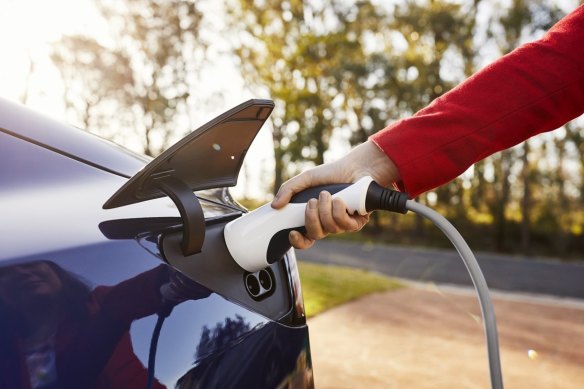By Mike Foley
People need more financial support to make the switch to electric cars and appliances to achieve the government’s 2030 climate target, as new figures reveal reductions in greenhouse gas emissions have stagnated over the past four years.
That is because emissions from the electricity sector, the dominant source of Australia’s greenhouse pollution, have begun to rise over the past six months.

Uptake of electric cars and household appliances will be key to achieving Australia’s climate goals.Credit: Supplied
Other sources of greenhouse gases must start to fall, and experts say the best place to start is where polluting options can be replaced by clean alternatives – namely electric vehicles and household appliances like electric water heaters and reverse cycle airconditioners.
The independent Climate Change Authority, headed by former NSW treasurer Matt Kean, last week released its blueprint for Australia to reach its goal of net zero emissions by 2050, which said all sectors of the economy must do more to lower emissions. It warned household gas connections may need to be banned if the uptake of clean options is too low.
“The best way to address the number one issue affecting most Australian households is through government-backed home electrification,” said Smart Energy Council chief executive John Grimes.
However, high upfront costs of cleaner technology is a handbrake on electrification.
Grimes will be part of a major campaign from the Australian Council of Trade Unions, Uniting Church, Smart Energy Council and Australian Council of Social Service to be launched in Canberra next week.
“One in three Australian households are already on this journey, but those who can’t afford the upfront costs that will lead to massive savings can’t be left behind,” Grimes said.
“Getting more solar, batteries and electric appliances into peoples homes is a no-brainer for a federal government staring down a cost-of-living crisis.”
Delays to major infrastructure projects have slowed the rollout of renewable energy needed to replace coal plants, offsetting pollution cuts from other sectors.
This trend looms as a major threat to the Albanese government’s legally binding 2030 climate target, which aims to cut emissions 43 per cent from 2005 levels.
The Climate Change Authority identified a need for government incentives.
“Well-configured public finance and public finance policy mechanisms can address the price premium barriers that are holding back the greater uptake of low-carbon transport alternatives,” the authority said.
Governments may need to prohibit the use of gas appliances altogether if uptake is too slow.
“Achieving the required rate of electrification is a significant challenge and may require prohibiting
new gas connections and appliance replacement in homes.”
Cost-of-living pressures have led to a slowdown in Australia’s shift away from combustion-engine cars. Electric vehicles accounted for about 8 per cent of all new sales in 2023 but have since dipped in popularity, now representing about 6 per cent of the new car market.
Australia’s energy market operator also released new figures in August that lowered its forecast of EV uptake by about a third. In December, it had predicted there would be 7 million EVs on the road by 2034, but it now expects around 4 million.
Emissions must fall consistently between now and 2030 to meet Australia’s legislated climate reduction target. But between January and March this year, the nation’s emissions rose 0.6 per cent, the National Greenhouse Gas Inventory said.
The deepest cuts to emissions are set to come from the electricity sector, where polluting coal-fired power plants are being replaced by clean renewable energy.
But electricity emissions rose 1.7 per cent in the March quarter, due to huge demand for electricity as households switched on their air-conditioners in a run of hot weather, which forced coal and gas plants to plug supply gaps after the sun went down.
Electricity emissions also rose 1.3 per cent in the June quarter, due to an increased use of coal and gas to back up renewables during a wind drought.
Australian governments signed an agreement in July to pursue energy reforms to boost household efficiency and make clean appliances more affordable for lower-income households.
Climate Change and Energy Minister Chris Bowen said the government had the right policies in place to reach its climate targets, including for household electrification.
Energy ministers agreed in July to establish nationally consistent rules for electric vehicles to export power stored in their batteries. They will also impose national energy efficiency standards for electric heat pumps, to encourage people to switch from gas, and develop new measures to to help those who cannot afford more expensive technologies.
“Electrification and the switch to renewables in our electricity system is well underway,” Bowen said.
“State, territory and federal ministers have made it clear that the focus of all governments is on the huge gains to be made by collaborating to implement Australia’s first ever national plan guiding household and consumer electrification.”
Get to the heart of what’s happening with climate change and the environment. Sign up for our fortnightly Environment newsletter.